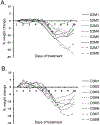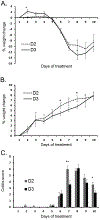Free versus total serum 25-hydroxyvitamin D in a murine model of colitis
- PMID: 30710745
- PMCID: PMC6502676
- DOI: 10.1016/j.jsbmb.2019.01.015
Free versus total serum 25-hydroxyvitamin D in a murine model of colitis
Abstract
Inflammatory bowel diseases (IBD) such as ulcerative colitis and Crohn's disease have been linked to vitamin D-deficiency. Using a dextran sodium sulphate (DSS)-induced model of IBD we have shown previously that mice raised on vitamin D-deficient diets from weaning have lower serum 25-hydroxyvitamin D (25OHD) levels and develop more severe colitis compared to vitamin D-sufficient counterparts. We have also shown in vitro that immune responses to 25OHD may depend on 'free' rather than total serum concentrations of 25OHD. To investigate the possible effects of free versus total 25OHD on anti-inflammatory immune responses in vivo we have studied DSS-induced colitis in wild type C57BL/6 mice raised from weaning on diets containing vitamin D2 (D2) or vitamin D3 (D3) only (both 1000 IU/kg feed). 25OHD2 has lower binding affinity for the vitamin D binding protein than 25OHD3 which results in higher levels of free 25OHD2 relative to free 25OHD3 in mice raised on a D2-only diet. Total serum 25OHD concentrations, measured by liquid chromatography-tandem mass spectrometry (LC-MS/MS), showed that D2 mice had significantly lower levels of 25OHD than D3 mice (6.85 ± 2.61 nmol/L vs. 49.16 ± 13.8 nmol/L for D2 and D3 respectively). Despite this, direct ELISA measurement showed no difference in free serum 25OHD levels between D2 and D3 mice (13.62 ± 2.26 pmol/L vs. 14.11 ± 2.24 pmol/L for D2 and D3 respectively). Analysis of DSS-induced colitis also showed no difference in weight loss or disease progression between D2 and D3 mice. These data indicate that despite D2-fed mice being vitamin D-deficient based on serum total 25OHD concentrations, these mice showed no evidence of increased inflammatory colitis disease relative to vitamin D-sufficient D3 mice. We therefore propose that free, rather than total serum 25OHD, may be a better marker of immune responses to vitamin D in vivo.
Keywords: Colitis; Free vitamin D; Inflammation; Mouse; Total vitamin D; Vitamin D; Vitamin D binding protein; Vitamin D2; Vitamin D3.
Copyright © 2019 Elsevier Ltd. All rights reserved.
Conflict of interest statement
Competing financial interests
The authors declare no competing financial interests.
Figures




References
-
- Hewison M, Antibacterial effects of vitamin D, Nature reviews. Endocrinology, 7 (2011) 337–345. - PubMed
-
- Liu PT, Stenger S, Li H, Wenzel L, Tan BH, Krutzik SR, Ochoa MT, Schauber J, Wu K, Meinken C, Kamen DL, Wagner M, Bals R, Steinmeyer A, Zugel U, Gallo RL, Eisenberg D, Hewison M, Hollis BW, Adams JS, Bloom BR, Modlin RL, Toll-like receptor triggering of a vitamin D-mediated human antimicrobial response, Science, 311 (2006) 1770–1773. - PubMed
-
- Hewison M, An update on vitamin D and human immunity, Clin Endocrinol (Oxf), 76 (2012) 315–325. - PubMed

